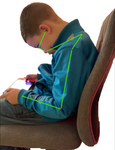Kurzfassung
Electronic media devices such as smartphones and tablets have become indispensable in everyday life. According to Statista, the number of smartphone users aged 14 and over in Germany is growing by around 3 million annually. The proportion of 6- to 7-year-olds in Germany who own a smartphone is around 6%, and for 8- to 9-year-olds it is 33%. Around 75% of young people between the ages of 10 and 11 have a smartphone. With the increased tendencyof the electronic media device usage, the...
Electronic media devices such as smartphones and tablets have become indispensable in everyday life. According to Statista, the number of smartphone users aged 14 and over in Germany is growing by around 3 million annually. The proportion of 6- to 7-year-olds in Germany who own a smartphone is around 6%, and for 8- to 9-year-olds it is 33%. Around 75% of young people between the ages of 10 and 11 have a smartphone. With the increased tendencyof the electronic media device usage, the number of people who report increasing neck pain is growing . The latest scientific studies show that increasing physical and musculoskeletal complaints reported by adolescents can be traced back to the use of digital media. These include, in particular, neck, back and eye pain. In this context, Daniella David defined a phenomenon called text neck syndrome. The text neck syndrome includes symptoms that are causally related to the inappropriate use of gadgets like smartphones, especially in childhood. Constantly looking at the smartphone, tablet or keyboard unintentionally forces the user to adopt an unphysiological upper body and head posture.
In order to gain new insights into impacts of the rapidly increasing use of digital media devices among children and adolescents in distance learning and in their free time, connections between stress on the cervical spine and medical, psychological and social impairments must be examined. The software-supported modeling and the simulation of the human spine are nowadays helpful tools to carry out the loads in the spinal structures while considering different applications. With such simulation models, long-term effects of an extremely bent upper body and a hanging head position (cell phone neck) can be calculated, which plays a major role in many orthopedic-medical aspects and treatment options.
In the “Smombi 2.0” project, methods are being developed that determine individual biomechanical properties of the cervical spine from 2D and 3D image data. More precisely, special features are extracted from a 2D or 3D image that can serve as landmark points for the determination of the parameters in the cervical spine. A great advantage of such RGB (D) image-based methods is that they are based only on visual perception and do not require any additional equipment other than standard image technology. An additional advantage of the image-based determination of cervical spine characteristics is that the patient examinations are carried out without physically influencing the subjects. Once the biomechanical parameters are determined, they are translated into a multi-body simulation model of the human cervical spine. In addition to the rigid bodies connected by joints, this model defines forces for intervertebral discs, ligaments, facet joints and muscles. The defined forces and moments in the cervical spine are calculated in a simulation run and then visualized and analyzed in the final step.
» weiterlesen» einklappen

